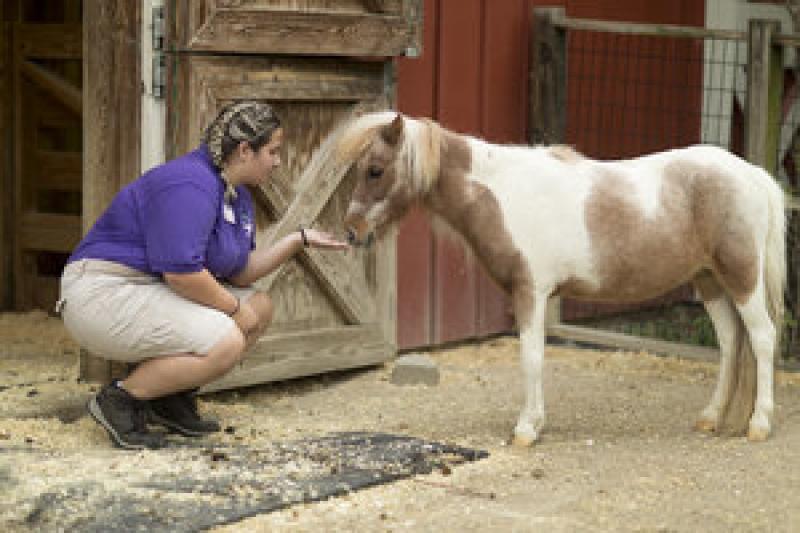How Zoo School in Ohio is helping teens prep for careers - and college
By: The Christian Science Monitor


Acting like animals on campus doesn't count.
IMO, a revival of vocational education would do much to correct many problems with our primary education system. But I question this emphasis on creating specialized schools based on narrow career choices. How many zookeepers does the country really need?
A more general approach based on agricultural practices would prepare the students to pursue more career paths. Specialized training should be obtained at the college level. These highly specialized high schools seem to be deliberately designed to make the idea of vocational training impractical.

Oct. 23, 2024 | Columbus, Ohio
It's just after 8:30 on a sunny Tuesday morning, and Kailyn Roush is all smiles. She is eager to traverse familiar terrain: the Columbus Zoo and Aquarium.
The zoo doesn't open for another 30 minutes, which gives her plenty of time to film a "keeper talk," an informational video about an animal. Kailyn and her project partner, Maddie Hehl, wrote and edited the script. They and another student, Maddie Howman, walk to the Asia Quest exhibit and find the red pandas - mother Kora and daughter Santi.
As the furry animals scurry in and out of sight and up a small tree, Kailyn and her partner take turns giving fun facts about the tiny duo. (Did you know that red pandas have to eat at least 20% of their body weight each day to survive? Or that the endangered animals' diet is mostly bamboo shoots and leaves?) They finish shooting and beseech viewers to get involved with animal conservation. Their next stop is a visit to the Pallas' Cat enclosure, where tiny 2-month-old twins cuddle with their mother.
"I've known since [age] 5, I'm going to work in a zoo," Kailyn says exuberantly. Her mother told her about this zoo opportunity when she was in the fifth grade. She applied in high school and earned a spot in the program run by the zoo and the Delaware Area Career Center (DACC), which offers career and technical training support for high schoolers and adult learners. Students enter DACC through a lottery, and there is a waiting list, with parents hungry to send their children there.
Zoo School, as it's called, is one of a plethora of programs from the center. It's also part of something that Ohio schools champion: career and technical education. And over the past 50 years, CTE has come a long way from wood shop. The zoo opportunity is an example of modern CTE, where young people get exposure in high school to career skills - and mentors - and a jump on a profession. But these days, that doesn't mean they're not going on to college: Most, if not, all of the Zoo School students will pursue degrees.
Ira Porter/The Christian Science Monitor High school friends (from left) Maddie Howman, Kailyn Roush, and Maddie Hehl spend time in their Zoo School classroom, Sept. 17, 2024, at the Columbus Zoo and Aquarium.
"I would say there was a stigma in career tech education, and I think to a certain extent there still is a little bit of a stigma, not on the part of the students, but on the part of the families," says Jay Poroda, superintendent of DACC.
He points to the waitlist for Zoo School as a broader shift in parental mindset. "I think parents are starting to realize that there's not just one path for success in the future," Mr. Poroda says.
Parents now see that CTE programs prepare students for college and career, he adds, and in Ohio, the proof is in the pudding.
A shift in thinking on CTE
Since it was founded in 2005, Zoo School has graduated 450 students. DACC officials say students have gone on to pursue careers in zoology, human or animal medicine, conservation, and ecology education. Some graduates who began careers in caring for wildlife have come back to speak to students. One owns a media company that specializes in filming endangered animals around the world.
Recent statistics back up the idea that CTE works, says Shayne Spaulding, a senior fellow and managing director of the CTE CoLab at the Urban Institute in Washington.
"The enrollment trends point to a shift in how CTE programs are perceived. Students are interested in focusing on careers in high school, and dual enrollment gives them the opportunity to get started on their careers at that age," Ms. Spaulding says.
In Ohio, career-technical planning districts - which organize requirements and offer programming for high school students - are celebrating 50 years. Today, 91 districts exist. Leaders in this Rust Belt state realized that workers had a skills deficit, with more jobs than trained people to fill them. Politicians reflected on the once vibrant economy of tradespeople who had mastered vocational skills, and why education had moved away from teaching it.
In 2014, the state's then-governor, Republican John Kasich, signed an education reform bill making Ohio one of the only states that required CTE courses for middle school students. Support for CTE was enhanced under that law, HB 487, which required having advisers for CTE students, course outlines for middle school students, and a modification to state graduation requirements that allowed multiple pathways to graduation, including recognizing industry credentials that students earn through CTE.
Courtesy of Delaware Area Career Center Delaware Area Career Center instructor Emily Cunningham (center) interacts with a group of students during classroom time at the Columbus Zoo and Aquarium in Ohio.
Republican Gov. Mike DeWine also has increased money for training in schools and equipment. The budget for 2024-2025 allocated $100 million in equipment upgrades, instructional materials, facilities, and operational costs. Schools across the state apply for the grant money. The stipulation is that they must offer a qualifying CTE program for careers listed on Ohio's Top Job list, or a qualifying credential program from the Innovative Workforce Incentive Program.
An additional $200 million was earmarked for the Career Technical Construction program in 2023. The money will be used to expand classrooms and training centers. This will result in more than 3,700 seats for students in programs like construction, engineering, manufacturing, health care, and operations.
"I think over time, as our economy has changed in this country, that people, parents, students, employers, educators, have come to the realization that career technical education reinforces academic learning. It doesn't keep you from going on to a four-year degree, and it also enriches the students," says Margaret Hess, executive director for the Ohio Association of Career Technical Superintendents.
Ms. Hess says that people realize that college isn't the only place where someone can learn marketable skills to make a decent living.
"This is fun"
Zoo School, for high school juniors and seniors, happens in two phases. During both years, students split their time between classroom learning and zoo activities. The first year they do two college level research projects on animals. They observe them with zookeepers, gather data, take a statistics class, learn to compile data and write research papers, and present their findings.
Senior year is more hands-on. They still do in class learning twice a week with instructor Emily Cunningham, a science teacher by trade. Here, they learn details of animals, habitats, and behaviors. Students also spend time prepping animal habitats, learning about animal diets and general animal care, and getting food ready. They aren't typically allowed to feed animals for safety reasons, but can observe. They started this school year learning about enrichment: stimulation for animals and tools placed into their habitats. Students tried to design their own toys or activities. If approved, zookeepers allow them to see animal reactions to their creation or to monitor enrichment that full-time keepers place in habitats.
Ira Porter/The Christian Science Monitor Zoo School students Zander Collin (left) and Reid Rogers take a break after they finished filming a "keeper talk" for the moose exhibit at the Columbus Zoo and Aquarium, Sept. 17, 2024.
"The goal is to get them exposed to what two different possible careers could be like, that they want to do someday when they are finished with the program," Ms. Cunningham says. She says she has seen students go on to become veterinarians or work in zoos, as well as become teachers.
Ms. Hess sees the benefits of CTE as a no-brainer in places like Ohio. "[CTE] is hands-on learning and it engages students in a way that sitting at a desk all day long doesn't always do," she says.
By exploring interest at an early age, students can avoid declaring a major for college, only to get to campus and realize that they don't want to do it. Additionally, she points to soft skills that students get through hands-on learning, such as working in teams and customer service.
Reid Rogers is well known among his peers at Zoo School. He is a senior who comes from a different high school than the students he laughs and studies with. He shares the same love of animals with them, and has conquered social anxiety because of them.
"I wouldn't say that I'm the most popular kid [at high school], but here, just having a small class and being with the same group of people for two years, you really get to know them," says Reid, who dreams of attending Ohio State University and becoming a conservationist. "It makes it easier, so you can be more comfortable around them."
He looks at ease as he and classmate Zander Collin film their "keeper talk" in front of the moose encampment. They have taken their three-minute talk a step further and switched up the scenery from the lone male moose at the zoo in the background, to a bridge over a pond with ducks in the water, to a metal statue of a moose where they sit, pose for pictures, and make funny faces.
"This is fun," Reid says, with a smile. "I've never personally thrived in the traditional bunch of desks in a room, sit-down-be-quiet-and-listen kind of lecture," he adds.
The hands-on experience that he gets from working with zookeepers and staff is what he was looking for.
"It's very interactive," he says. "And for me personally, that makes learning a lot more fun and a lot less boring, and it makes me excited to come here."
Ira Porter's reporting for this story was supported by the The Institute for Citizens & Scholars' Higher Education Media Fellowship.




IMO this is the right idea being poorly executed. Creating highly specialized vocational high schools seems to be deliberately intended to foster public opposition; an intentional plan for failure.